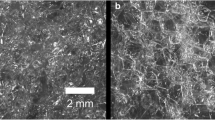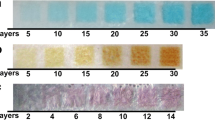Abstract
Three different formulations comprising two drugs, felodipine and hydrochlorothiazide (HCT) and two polymers, poly(vinyl pyrolidone) (PVP) and poly(lactic-co-glycolic acid) (PLGA) were inkjet printed as micro-dot arrays and analysed on an individual micro-spot basis by time-of-flight secondary ion mass spectrometry (ToF-SIMS). For the HCT/PLGA formulation, the spots showed heterogeneity of the drug and other chemical constituents. To further investigate these heterogeneities, multivariate curve resolution was applied to the ToF-SIMS hyperspectral image datasets. This approach successfully identified distinct chemical components elucidating the HCT, PLGA, substrate material, and contaminants based on sulphur, phosphorous and sodium chloride. Spots printed using either of the drugs with PVP exhibited full substrate coverage and a uniform distribution of the active ingredient along with all other constituents within the printed spot area. This represents the preferred situation in terms of stability and controlling the release of a drug from a polymer matrix.





Similar content being viewed by others
References
Scoutaris N, Alexander MA, Gellert PR, Roberts CJ. Inkjet printing as a novel medicine formulation technique. J Control Release. 2011. doi:10.1016/j.jconrel.2011.07.033.
Chan KLA, Kazarian SG. Fourier transform infrared imaging for high-throughput analysis of pharmaceutical formulations. J Comb Chem. 2005;7(2):185–9.
Cui XY, Hutt DA, Scurr DJ, Conway PP. The evolution of Pd/Sn catalytic surfaces in electroless copper deposition. J Electrochem Soc. 2011;58(3):D172–7.
Urquhart AJ, Taylor M, Anderson DG, Langer R, Davies MC, Alexander MR. TOF-SIMS analysis of a 576 micropatterned copolymer array to reveal surface moieties that control wettability. Anal Chem. 2008;80(1):135–42.
Scurr DJ, Horlacher T, Oberli MA, Werz DB, Kroeck L, Bufali S, et al. Surface characterisation of carbohydrate microarrays. Langmuir. 2010;26(22):17143–55.
Belu AM, Davies MC, Newton JM, Patel N. TOF-SIMS characterisation and imaging of controlled-release drug delivery systems. Anal Chem. 2000;72(22):5625–38.
Lee JLS, Gilmore IS. The application of multivariate data analysis techniques. In: Vickerman JC, Gilmore IS, editors. Surface analysis: the principal techniques. 2nd ed. Chichester: John Wiley & Sons Ltd; 2009.
Vervaet C, Remon JP. Bioavailability of hydrochlorothiazide from pellets, made by extrusion/spheronisation, containing polyethylene glycol 400 as a dissolution enhancer. Pharm Res. 1997;14(11):1644–6.
Konno H, Taylor L. Ability of different polymers to inhibit the crystallisation of amorphous felodipine in the presence of moisture. Pharm Res. 2008;25(4):969–78.
Karavas E, Georgarakis M, Docoslis A, Bikiaris D. Combining SEM, TEM, and micro-Raman techniques to differentiate between the amorphous molecular level dispersions and nanodispersions of a poorly water-soluble drug within a polymer matrix. Int J Pharm. 2007;340(1–2):76–83.
Kim E-J, Chun M-K, Jang J-S, Lee I-H, Lee K-R, Choi H-K. Preparation of a solid dispersion of felodipine using a solvent wetting method. Eur J Pharm Biopharm. 2006;64(2):200–5.
Konno Hajime, Taylor LS. Influence of different polymers on the crystallisation tendency of molecularly dispersed amorphous felodipine. J Pharm Sci. 2006;95(12):2692–705.
Edwards DA, Hanes J, Caponetti G, Hrkach J, Ben-Jebria A, Eskew ML, et al. Large porous particles for pulmonary drug delivery. Science. 1997;276(5320):1868–72.
Kim D-H, Martin DC. Sustained release of dexamethasone from hydrophilic matrices using PLGA nanoparticles for neural drug delivery. Biomaterials. 2006;27(15):3031–7.
Anderson JM, Shive MS. Biodegradation and biocompatibility of PLA and PLGA microspheres. Adv Drug Deliv Rev. 1997;28(1):5–24.
Jain RA. The manufacturing techniques of various drug loaded biodegradable poly(lactide-co-glycolide) (PLGA) devices. Biomaterials. 2000;21(23):2475–90.
Tajber L, Corrigan OI, Healy AM. Physicochemical evaluation of PVP-thiazide diuretic interactions in co-spray-dried composites—analysis of glass transition composition relationships. Eur J Pharm Sci. 2005;24(5):553–63.
Acknowledgment
The authors gratefully acknowledge the provision of a PhD studentship to Nikolaos Scoutaris by the EPSRC/Astra Zeneca Targeted Therapeutics to Next Generation Medicine: Centre for Doctoral Training.
Author information
Authors and Affiliations
Corresponding author
Electronic supplementary material
Below is the link to the electronic supplementary material.
Rights and permissions
About this article
Cite this article
Scoutaris, N., Hook, A.L., Gellert, P.R. et al. ToF-SIMS analysis of chemical heterogenities in inkjet micro-array printed drug/polymer formulations. J Mater Sci: Mater Med 23, 385–391 (2012). https://doi.org/10.1007/s10856-011-4474-5
Received:
Accepted:
Published:
Issue Date:
DOI: https://doi.org/10.1007/s10856-011-4474-5




